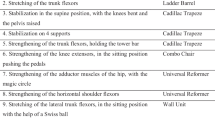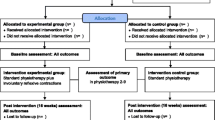Abstract
The aim of this study was to determine the efficacy of the Paula method of circular muscle training in the management of stress incontinence (SI). The theory behind this method states that activity of distant sphincters affects other muscles. In a pilot study, 59 women, mainly hospital employees, were randomly assigned to participate in exercises according to the Paula method or pelvic floor training. Efficacy was measured by reports of incontinence, quality of life (I-QOL), pad test, and pelvic floor muscle strength (assessed by perineometer and digital examination). Both the Paula exercises and pelvic floor training produced significant changes in urinary leakage compared to baseline as measured by the pad test [mean decrease of 5.4 g (p=0.002) and 9.5 g (p=0.003), respectively]. Women randomized to the Paula method reported improvement in I-QOL scores. The Paula method was found to be efficacious for SI in a population of Israeli women. Larger community-based studies will be required to confirm these results and enable evaluation of between-group differences.


Similar content being viewed by others
References
Abrams P, Cardozo L, Fall M, Griffiths D, Rosier P, Ulmsten U, van Kerrebroeck L, Victor A, Wein A (2002) The standardisation of terminology of lower urinary tract function. Report from the Standardisation Sub-committee of the International Continence Society. Neurourol Urodyn 21:167–178
Milsom I, Ekelund P, Molander U, Arvidsson L, Areskoug B (1993) The influence of age, parity, oral contraception, hysterectomy and the menopause on the prevalence of urinary incontinence in women. J Urol 149:1459–1462
Ifrah A (ed) (1999) Incontinence. Women’s health in Israel, 1st edn. Hadassah, Israel, p 128
Holtedahl K, Verelst M, Schiefloe A (1998) A population based, randomized controlled trial of conservative treatment for urinary incontinence in women. Acta Obstet Gynecol Scand 77:671–676
Milsom I (2000) The prevalence of urinary incontinence. Acta Obstet Gynecol Scand 79:1056–1059
Kegel AH (1948) Progressive resistance exercise in the functional restoration of the perineal muscle. Am J Obstet Gynecol 56:238–248
Thakar R, Stanton S (2000) Management of urinary incontinence in women. Br Med J 321:1326–1331
Bo K, Talseth T, Holme I (1999) Single blind, randomized, controlled trial of pelvic floor exercises, electrical stimulation, vaginal cones and no treatment in management of genuine stress incontinence woman. Br Med J 318:487–493
Kegel A (1956) Stress incontinence of urine in women: physiologic treatment. J Int Coll Surg 25:487–499
Hahn I, Milson I, Fall M, Ekelund P (1993) Long term results of pelvic floor training in female stress urinary incontinence. J Urol 72:421–427
Cammu H, Van Nylen M, Derde MP, DeBruyne R, Amy JJ (1991) Pelvic physiotherapy in genuine stress incontinence. Urology 38:332–337
Hay-Smith EJC, Berghmans LCM, Hendriks HJM, de Bie RA, van Waalwijk van Doorn ESC (2003) Pelvic floor muscle training for urinary incontinence in women. In: The Cochrane Library, Issue 3
Garburg P (1994) Self healing. The secret of the ring muscles, 2nd edn. Peleg Publishers, Hadera
Yom-Tov S, Golani I (1993) Oscillators in human body and circular muscle gymnastics. Med Hypotheses 41:118–122
Yom-Tov E, Yom-Tov S, Ur H (1999) A model of induced coupled movements in the human body: a case study. Biol Cybern 80:411–416
Goldhammer A (1995) Paula method, the circular muscles exercises (in Hebrew). Prolog, Tel-Aviv
Abrams P, Blaivas JG, Stuart L (1988) The standardization of terminology of lower urinary tract function. Scand J Nephrol Suppl 114:5–18
Patrick DL, Martin ML, Bushnell DMI, Yalcin I, Wagner TH, Buesching DP (1999) Quality of life of women with urinary incontinence: further development of the incontinence quality of life instrument (I-QOL). Urology 53:71–76
Abramson JH (1997) Survey methods in community medicine. Churchill Livingstone, New York, p 49
Lose G, Fantl J, Victor A, Walter S, Wells TL, Wyman J, Mattiasson A (1998) Outcome measures for research in adult women with symptoms of lower urinary tract dysfunction. Neurourol Urodyn 17:255–256
Arvonen T, Fianu-Jonasson A, Tyni-Lenne R (2001) Effectiveness of two conservative modes of physical therapy in women with urinary stress incontinence. Neurourol Urodyn 20:591–599
Acknowledgments
This work was supported by an Internal Grant for Paramedical Personnel at Hadassah and the Lillian Silverstein Fund.
Author information
Authors and Affiliations
Corresponding author
Appendix
Appendix
Rights and permissions
About this article
Cite this article
Liebergall-Wischnitzer, M., Hochner-Celnikier, D., Lavy, Y. et al. Paula method of circular muscle exercises for urinary stress incontinence—a clinical trial. Int Urogynecol J 16, 345–351 (2005). https://doi.org/10.1007/s00192-004-1261-6
Received:
Accepted:
Published:
Issue Date:
DOI: https://doi.org/10.1007/s00192-004-1261-6




